Preparation Manual
Section 4: Sample Selected-Response Questions Music EC–12 (177)
Expand All Answers | Collapse All Answers
This section presents some sample exam questions for you to review as part of your preparation for the exam. To demonstrate how each competency may be assessed, sample questions are accompanied by the competency that they measure. While studying, you may wish to read the competency before and after you consider each sample question. Please note that the competency statements do not appear on the actual exam.
For each sample exam question, there is a correct answer and a rationale for each answer option. The sample questions are included to illustrate the formats and types of questions you will see on the exam; however, your performance on the sample questions should not be viewed as a predictor of your performance on the actual exam.
Domain I—Listening
Competency 001—The teacher applies standard terminology to describe and analyze various elements in a musical recording.
Click to play the audio stimulus associated with this question.
1. Which THREE of the following statements accurately describe the piece?
- It is primarily Aeolian.
- It is primarily Mixolydian.
- It features antiphonal voicing.
- It ends in unison.
- The harmonies most often used are tertian.
- Enter to expand or collapse answer.Answer expanded
- Option A is correct because the work is clearly Aeolian. Option C is correct because the alternation of melodic movement between the right-hand and left-hand parts is antiphonal. Option E is correct because most of the harmonies are dyadic and are written exclusively in thirds. Option B is incorrect because the work is not Mixolydian. A single use of the raised sixth in the left hand does not change the overall mode. Option D is incorrect because the work ends in an octave, not in a unison.
The excerpt used for the question is Bartok: Mikrokosmos, Volume III, No. 67.
Competency 001—The teacher applies standard terminology to describe and analyze various elements in a musical recording.
Click to play the audio stimulus associated with this question.
2. Which of the following compositional devices are heard in the excerpt?
- Hemiola and anacrusis
- Diminution and hemiola
- Sequence and diminution
- Sequence and anacrusis
- Enter to expand or collapse answer.Answer expanded
- Option D is correct because the excerpt starts on a characteristic anacrusis, and except for movement to cadences, the excerpt is built almost exclusively on sequential repetition. Option A is incorrect because, although there is an anacrusis, there is no hemiola, a technique especially unlikely in this meter. Option B is incorrect because there is no clear use of diminution of a figure or motive and because there is no hemiola. Option C is incorrect because although there is sequence, there is no clear use of diminution of a figure or motive.
The excerpt used for the question is from Cello Suite No. 4: Bourrée by J. S. Bach.
Questions 3 and 4 are based on a single excerpt.
Click to play the audio stimulus associated with these questions.
Competency 001—The teacher applies standard terminology to describe and analyze various elements in a musical recording.
3. What is the predominant texture of the excerpt?
- Homophonic
- Polyphonic
- Monophonic
- Heterophonic
- Enter to expand or collapse answer.Answer expanded
- Option A is correct because the overall texture is primarily instruments playing chorale style in the same rhythm. The occasional harp statements do not change the fact that the predominant texture is homophonic. Option B is incorrect because there is no temporal separation of multiple lines. Option C is incorrect because there are numerous lines in chorale style. Monophonic music features only one line. Option D is incorrect because there are no variations on a single melodic line that occur simultaneously.
The excerpt used for the question is from Nutcracker Suite: “Waltz of the Flowers” by Tchaikovsky. Courtesy of Entertainment One, U.S. LP.
Competency 002—The teacher recognizes and describes music of varied genres, styles and cultures in a musical recording.
4. Who is the composer of the work?
- Piotr Ilyich Tchaikovsky
- Gustav Mahler
- Francis Poulenc
- Alexander Scriabin
- Enter to expand or collapse answer.Answer expanded
- Option A is correct because the excerpt contains melodic and harmonic material that is typical of Tchaikovsky’s orchestral writing. Options B, C and D are incorrect because Mahler, Poulenc and Scriabin all composed orchestral works, but each wrote in a unique style that is different from that of the excerpt played.
The excerpt used for the question is from Nutcracker Suite: “Waltz of the Flowers” by Tchaikovsky. Courtesy of Entertainment One, U.S. LP.
Competency 003—The teacher evaluates and critiques musical compositions and performances in a musical recording.
Click to play the audio stimulus associated with this question.
5. The excerpt features dynamic variation as a means of expression. The changes in dynamics most clearly serve which of the following purposes?
- Contrasting an initial theme with a variation
- Emphasizing dominant-to-tonic resolution
- Shaping the phrase and eventual cadential arrival
- Delineating between the A and B sections
- Enter to expand or collapse answer.Answer expanded
- Option C is correct because the primary change in dynamics delineates the peak of the phrase, and the subsequent diminuendo, arriving at the quietest point in the excerpt, serves to reinforce the cadence. Option A is incorrect because the excerpt does not use theme and variation form. Option B is incorrect because there is no use of the traditional dominant-tonic relationship in the excerpt. Option D is incorrect because the dynamic change takes place within a section, and there is no movement to a contrasting section.
The excerpt used for the question is from William Schuman: American Hymn. Recording: American Hymn by American Brass Quintet from "American Visions" Summit Records (SMT 365).
Questions 6 and 7 are based on an excerpt for woodwind quintet.
Click to play the audio stimulus associated with these questions.
Competency 003—The teacher evaluates and critiques musical compositions and performances in a musical recording.
6. During the initial entrances, which of the following instruments enters last?
- Flute
- French horn
- Bassoon
- Clarinet
- Enter to expand or collapse answer.Answer expanded
- Option C is correct because the range and timbre help to identify the bassoon’s entrance, about eight seconds into the excerpt. Option A is incorrect because the flute enters before the bassoon. Option B is incorrect because the French horn is the first instrument heard. Option D is incorrect because the clarinet enters before the bassoon.
The excerpt used for the question is from the first movement (Schwungvoll) of the Wind Quintet, Op. 26, by Arnold Schoenberg. Recording: Phoenix Ensemble performs Schoenberg. (Albany Records).
Competency 002—The teacher recognizes and describes music of varied genres, styles and cultures in a musical recording.
7. Who is the composer of the excerpt?
- Gabriel Fauré
- Arnold Schoenberg
- Nikolai Rimsky-Korsakov
- Richard Strauss
- Enter to expand or collapse answer.Answer expanded
- Option B is correct because the harmonic language and style of writing are characteristic of Schoenberg’s twelve-tone style of composition. Option A is incorrect because Fauré’s works are characteristic of the Romantic style. Option C is incorrect because Rimsky-Korsakov wrote in the late Romantic style. Option D is incorrect because Strauss’s works are characteristic of the late Romantic style.
The excerpt used for the question is from the first movement (Schwungvoll) of the Wind Quintet, Op. 26, by Arnold Schoenberg. Recording: Phoenix Ensemble performs Schoenberg. (Albany Records).
Competency 003—The teacher evaluates and critiques musical compositions and performances in a musical recording.
Click to play the audio stimulus associated with this question.

A written monophonic French horn melody is presented. It is eight measures long, in F major, and has a five-eight time signature. Since the question pertains to articulation, the following information will describe the articulations used in the four measures listed in the four response options. Measure 2 has a quarter note, a staccato eighth note, and two slurred eighth notes. Measure 3 has three eighth notes, the last of which is staccato, and two slurred eighth notes. Measure 5 has a staccato eighth note followed by two pairs of slurred eighth notes. Measure 6 has a quarter note, a staccato eighth note, and two slurred eighth notes.
8. Which measure is performed with errors in articulation?
- 2
- 3
- 5
- 6
- Enter to expand or collapse answer.Answer expanded
- Option A is correct because all of the notes in measure 2 are performed as slurred, rather than with the articulations marked. Options B, C and D are incorrect because the articulations provided in measures 3, 5 and 6 are performed correctly.
Domain II—Music Theory and Composition
Competency 004—The teacher knows how to read, write and interpret standard music notation.
9. A score passage marked rubato suggests to the performer that the most significant change occurs in which of the following?
- Articulations
- Dynamics
- Pitch
- Tempo
- Enter to expand or collapse answer.Answer expanded
- Option D is correct because the term rubato suggests robbing of some time in one part of a phrase to be given back elsewhere. For example, a broadening of tempo at one moment might suggest a quickening of tempo later on. Option A is incorrect because, although rubato might impact articulations in an ancillary manner, the instruction is not directed toward articulation. Options B and C are incorrect because rubato has nothing to do with either dynamics or pitch.
Competency 004—The teacher knows how to read, write and interpret standard music notation.
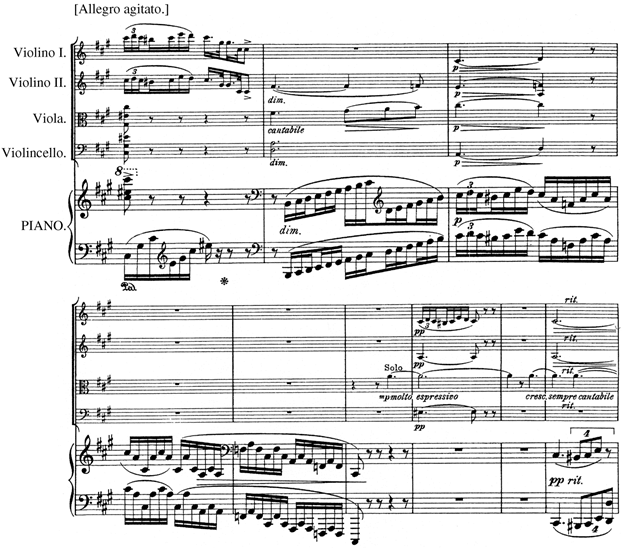
In measure two the viola has a cantabile melody consisting of a dotted quarter note followed by three eighth notes beamed together. In the following measure tutti strings have a dotted quarter note tied to a quarter note followed by an eighth rest. The piano then plays two measures of sixteenth notes. Each measure consists of twelve sixteenth notes beamed in groups of six. Their harmonic rhythm indicates arpeggiation.
10. The score excerpt is an example of which of the following types of meter?
- Simple duple
- Compound duple
- Simple triple
- Compound triple
- Enter to expand or collapse answer.Answer expanded
- Option B is correct because the grouping of the notes indicates two beats per measure (a duple meter) and that each beat is divided into three parts (compound). Options A, C and D are incorrect because these provide incorrect combinations of the number of beats per measure and the types of divisions of the beat.
The excerpt used for the question is from Piano Quintet in F-sharp Minor, Op. 67, third movement (Allegro agitato) by Amy Beach.
Competency 004—The teacher knows how to read, write and interpret standard music notation.
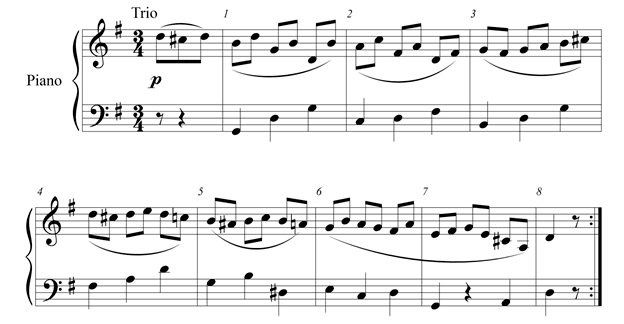
In the first six measures the right hand presents eighth notes exclusively while the left hand plays quarter notes exclusively. In measure 1 the bass ascends G-D-G while the right hand plays B on the first and last eighth notes. In measure 2 the bass ascends C-D-F-sharp while the melody begins with an A. In measure 3 the left hand ascends B-D-G. In measure 4 the bass ascends F-sharp-A-D while the melody ends on C-natural. In measure 5 the bass pitches are G, B, and descending D-sharp while the six notes of the melody are B, A-sharp, B, C, B, A-natural. The downbeat of measure 6 has E in the bass supporting eighth notes G and B.
11. Which of the following Roman numeral analyses best represents the harmonic progression in the excerpt through the first beat of measure 6?
- I ii6 V6 I6 I V65/V V7
- I ii6 I6 V65 I vi V7/V V
- I V42 I6 V65 V/V V7 vi
- I V42 I6 V65 I V65/vi vi
- Enter to expand or collapse answer.Answer expanded
- Option D is correct because the harmonic rhythm and main bass-line motion occur on the downbeats until measure five, where a hemiola occurs and the harmony on beat three becomes significant. Options A, B and C are incorrect because each of these options lists a number of incorrect harmonies and/or inversions.
The excerpt used for the question is from Six Minuets WoO 10, (Minuet #2), by Ludwig van Beethoven.
Competency 005—The teacher understands methods and techniques of musical composition and improvisation and knows how to arrange music for specific purposes and settings.
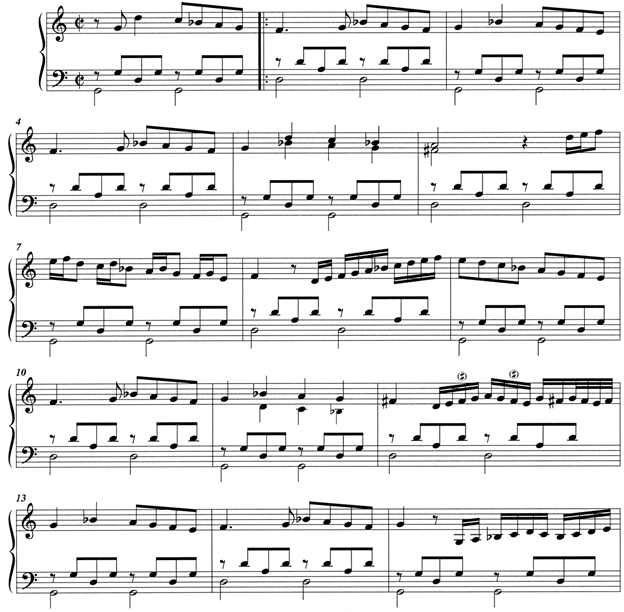
In the bass clef, the bass voice consistently presents two half notes while the tenor voice consistently presents an eighth rest followed by three eighth notes. The right hand presents several different rhythms including eighth notes and quarter notes, a dotted quarter note followed by eighth notes, and two sixteenths followed by an eighth note.
12. Which of the following compositional devices are used throughout the excerpt for harpsichord shown above?
- Isorhythm and fragmentation
- Ostinato and variation
- Fugato and inversion
- Enharmonic modulation and augmentation
- Enter to expand or collapse answer.Answer expanded
- Option B is correct because the excerpt contains a very clear example of ostinato since the left-hand material repeats every two measures, and it contains an example of variation because the right hand plays a series of two-measure variations. Option A is incorrect because isorhythm is used, but it is used inconsistently with the meter and not in the fourteenth-century style by which it is most often identified. There is no clear motivic fragmentation. Option C is incorrect because neither fugato nor inversion is present in the excerpt. Option D is incorrect because there is no modulation in the excerpt. Enharmonic modulation is used in a completely different style of music and era. Augmentation might be seen between measures 4 and 5, but it is not used consistently throughout the excerpt.
The excerpt used for the question is from My Lady Carey’s Dompe, anonymous 15th Century.
Competency 005—The teacher understands methods and techniques of musical composition and improvisation and knows how to arrange music for specific purposes and settings.
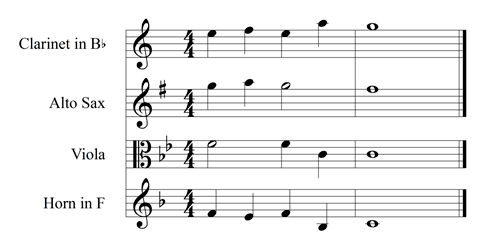
On the last beat of measure one, the following written pitches occur from bottom to top: French horn has a B-flat, viola has a C, the alto saxophone has a G, and the clarinet has an A above the staff.
13. What is the quality and inversion of the chord on the fourth beat of the first measure?
- An F dominant seventh in third inversion
- A B-flat major triad in second inversion
- An E-flat major triad in root position
- A C minor seventh in first inversion
- Enter to expand or collapse answer.Answer expanded
- Option D is correct because the chord indicated is the supertonic 7 (C minor 7) chord in B-flat major, which occurs in a typical place in the progression. From the lowest staff to the highest staff, the concert pitches are E-flat (horn), C (viola), B-flat (alto saxophone) and G (clarinet). The E-flat bass pitch occurs in the horn part. Because this pitch is the third of the chord, it is in first inversion. Option A is incorrect because only two of the concert pitches in the excerpt are in the F dominant 7 chord. Option B is incorrect because the pitches written do not constitute a Bb major chord. Option C is incorrect because the three pitches needed for an E-flat major chord are present, and E-flat is in the bass voice, but the concert C sounding in the viola is not a pitch in an E-flat triad.
Competency 005—The teacher understands methods and techniques of musical composition and improvisation and knows how to arrange music for specific purposes and settings.
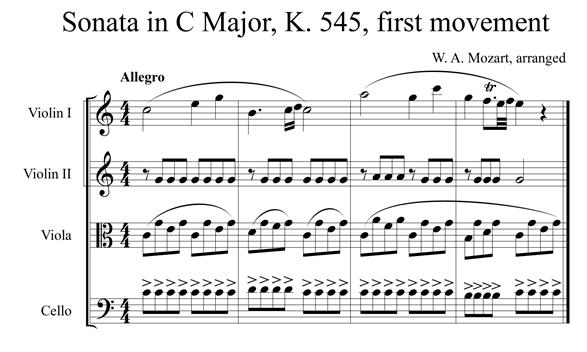
Violin one presets the melody grouped under two two-measure slurs. Violin two presents Gs in measures 1, 2, and 4, while measure 3 presents As in the first half of the measure and Gs in the second half. The viola is written using a traditional C clef and presents the Alberti bass of the left hand. The cello presents the following series of eighth notes, all accented: measure 1 eight Cs, measure 2 four Ds followed by four Cs, measure 3 eight Cs, measure 4 four Bs followed by four Cs.
14. The excerpt above, arranged for string quartet, has several flaws. Which THREE of the following statements describe flaws in the arrangement?
- The second violin part has notated pitches not otherwise found in the harmony.
- The accents in the cello will render the part too loud.
- The viola part is written in the incorrect clef.
- The slurring indications for first violin and viola are, for the most part, too long for practical playing in the style.
- The overall thickness of the scoring might create balance problems between the accompanying parts and the melody in the first violin part.
- Enter to expand or collapse answer.Answer expanded
- Option B is correct because there is no need for the accents in the cello. They are stylistically inappropriate and will create ensemble and balance problems. Option D is correct because the slurs in the first violin and viola parts look more like phrasing markings found in piano music. It would be difficult and unnecessarily confining for performers to play these figures in one bow. Option E is correct because the scoring of the Alberti bass figure is far thicker than it needs to be. The players would need to work hard to balance the melody. Option A is incorrect because the second violin pitches are all consistent with the harmony. Option C is incorrect because the viola is written in the correct clef.
Domain III—Music History and Culture
Competency 006—The teacher demonstrates a comprehensive knowledge of the history of Western music.
15. Which of the following composers wrote the chamber work Quartet for the End of Time, which includes imitations of bird calls?
- Jean-Philippe Rameau
- Robert Schumann
- Olivier Messiaen
- Maurice Ravel
- Enter to expand or collapse answer.Answer expanded
- Option C is correct because Messiaen wrote Quatour pour la fin du temps (translated as Quartet for the End of Time) while he was a prisoner of war during the Second World War. The work includes imitations of bird calls in the figures played by the violin and the clarinet. Options A, B and D are incorrect because Rameau, Schumann and Ravel also wrote works that reference birds, but they did not write the chamber work indicated. Rameau wrote Le Rappel des Oiseaux and La Poule, but both works were for keyboard. Schumann composed a well-known piece titled Vogel als Prophet (The Prophet Bird) as part of Waldszenen, op. 82, but it is a work for solo piano. Ravel included Oiseaux Tristes in his collection of piano pieces titled Miroirs.
Competency 006—The teacher demonstrates a comprehensive knowledge of the history of Western music.
16. The keyboard études of which of the following composers are widely recognized as the first to combine technical demands with artistic merit and have become part of the core concert repertoire for professional performers?
- Carl Czerny
- Frédéric Chopin
- Muzio Clementi
- Béla Bartók
- Enter to expand or collapse answer.Answer expanded
- Option B is correct because Chopin’s études for piano, some of which were first published in 1833, represent a historically significant combination of technical demands in pieces with artistic merit. The études are widely performed. Options A and C are incorrect because Czerny and Clementi wrote many keyboard études. Their exercises are popular as teaching tools but do not constitute a part of the core repertoire for concert performance. Option D is incorrect because Bartók’s works include études of significance, but his were not written until the early 1900s.
Competency 006—The teacher demonstrates a comprehensive knowledge of the history of Western music.
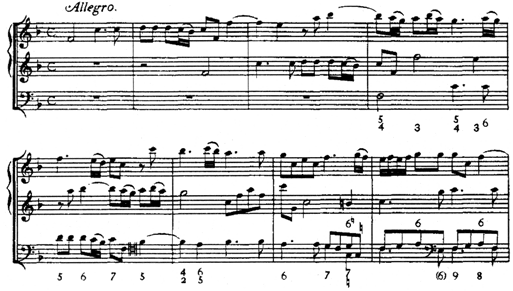
Below the lowest staff are Arabic numbers, thus indicating a figured bass.
17. The excerpt above is taken from which of the following genres?
- A trio sonata
- A piano trio
- A serenade
- A motet
- Enter to expand or collapse answer.Answer expanded
- Option A is correct because this is a standard example of a trio sonata, which has parts for two solo instruments and a continuo. Option B is incorrect because a piano trio typically features violin, cello (which would be written in bass clef) and piano. In addition, the presence of a figured bass is unusual in such a work. Option C is incorrect because a serenade is an instrumental genre for any variety of combinations. Serenades are typically found in the Classical era, during which time the use of a figured bass was becoming increasingly rare. Option D is incorrect because a motet is typically a vocal genre.
The excerpt used for the question is from the Trio Sonata Op. 3, No. 1, by Arcangelo Corelli.
Competency 006—The teacher demonstrates a comprehensive knowledge of the history of Western music.
Question 18 refers to the excerpt below.
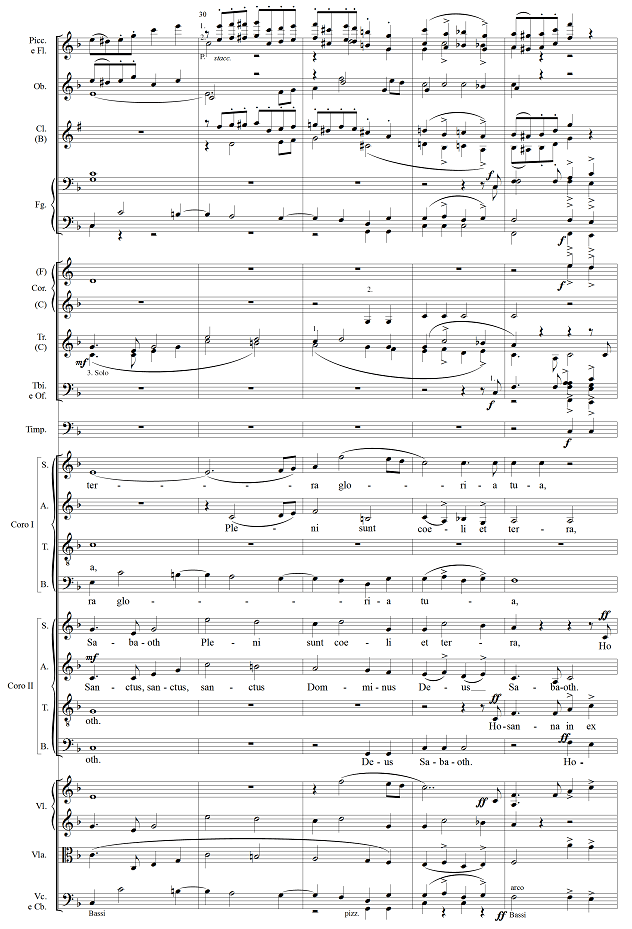
The text of the first chorus in the soprano is “terra gloria tua” and in the alto is “Pleni sunt coeli et terra.” The text of the second chorus is the following: Soprano-“Sabaoth Pleni sunt coeli et terra, Ho-;” Alto-“Sanctus, sanctus, sanctus Domminus Deus Sabaoth; Tenor-“Hosanna in ex-;”Bass “Deus Sabaoth Ho-.”
18. The excerpt is from the
- Classical era and is based on a secular text.
- Post-Tonal era and is based on a secular text.
- Baroque era and is based on a sacred text.
- Romantic era and is based on a sacred text.
- Enter to expand or collapse answer.Answer expanded
- Option D is correct because the text is from the Roman Mass liturgy (Sanctus), and the size of the orchestra, the instruments used, the double chorus and harmonic language mark the text as being from the Romantic era. Option A is incorrect because the text is sacred, and the forces are far too large for any work from the Classical era. Option B is incorrect because the text is sacred, and the language is tonal. Option C is incorrect because the size and nature of the orchestra is not consistent with that seen in the Baroque era.
The excerpt used for the question is from the Requiem by Giuseppe Verdi.
Competency 007—The teacher understands music of varied genres, styles and cultures and knows how music can reflect elements of a specific society or culture.
19. Ensembles performing which of the following music styles characteristically include vocals, piano, bass and brass as well as polyrhythms played using congas, bongos, timbales and cowbell?
- Swing
- Rock
- Bebop
- Salsa
- Enter to expand or collapse answer.Answer expanded
- Option D is correct because salsa ensembles typically include vocals, brass, a piano, bass and a variety of Cuban percussion instruments. A polyrhythmic context is created by layering individual rhythms. Option A is incorrect because swing bands typically use vocals, brass, woodwinds and rhythm sections but do not characteristically have the percussion instruments listed. The rhythm sections of swing bands do not normally perform polyrhythms. Option B is incorrect because rock music is usually performed by singers and using electric guitars, bass, keyboards and drums. Polyrhythms are used infrequently in rock music and are not characteristic of a rock ensemble. Option C is incorrect because bebop is a style of jazz that reflects the influence of swing. Improvisation and virtuosity are important aspects of the style. Bebop bands usually include a rhythm section consisting of piano, bass and drums.
Competency 007—The teacher understands music of varied genres, styles and cultures and knows how music can reflect elements of a specific society or culture.
20. Which of the following types of music was first produced for African American audiences by African American musicians, then became popular with White teenagers and subsequently played a part in ending segregation in the United States?
- Rhythm and blues
- Punk rock
- Fusion
- World beat
- Enter to expand or collapse answer.Answer expanded
- Option A is correct because the early development of rhythm and blues music was largely centered in the African American community. The popularity of rhythm and blues music among White teenagers led to increased interaction between individuals of different races in many facets of society, which helped end segregation. Option B is incorrect because the early development of punk rock was not centered in the African American community, and it occurred largely after significant progress had already been made to address segregation during the period from the 1950s through the early 1970s. Option C is incorrect because fusion is a 1970s development in jazz. Option D is incorrect because world beat became popular in the 1980s. Historically, it has not been connected with progress made in the Civil Rights movement in the United States.
Domain IV—Music Classroom Performance
Competency 008—The teacher demonstrates knowledge of methods and techniques for singing.
21. A choral director has chosen a piece of music for an eighth-grade mixed choir. The piece is appealing to the students and is appropriate for the group. The girls’ parts include a wide range, but the girls are able to sing the parts. The boys’ parts are occasionally out of their comfortable range. The best strategy for the director to use to resolve the range issue for the boys is to
- choose another piece.
- transpose the piece to a different key so that the boys’ parts are in a higher range.
- have the boys’ sing the girls’ parts an octave lower throughout the entire piece.
- have the boys move between different voice parts to accommodate their comfortable range.
- Enter to expand or collapse answer.Answer expanded
- Option D is correct because choral music is frequently out of the limited range of boys’ changing voices. Many choral educators suggest using a voice pivoting approach for boys so that their parts are comfortably within their range. Option A is incorrect because choosing another piece is not the best option if the original piece is one that is desirable and can be performed as long as adjustments are made for the boys. Option B is incorrect because the parts use a large range for the girls. Transposition would likely put the girls’ parts out of their comfortable range. Option C is incorrect because the range for the girls’ parts is large. When boys’ voices are changing, they frequently have a much smaller range than girls have.
Competency 009—The teacher demonstrates knowledge of methods and techniques for playing musical instruments.

Measures one and two are identical. The following rhythms appear from bottom to top. In the first space below the staff on beats two and four are quarter notes with an x as the note head. In the first space on the staff are four quarter notes with normal note heads. On the third space of the staff are quarter notes with normal note heads on beats two and four. On the top space above the staff are x-shaped note heads. Beat one is a quarter note and beat two is a dotted-eighth and sixteenth pair. Beats three and four are identical to beats one and two.
22. The notation on beats two and four in the measures above indicates which drum-set parts, starting from the note underneath the staff?
- Snare drum, hi-hat, bass drum, ride cymbal
- Ride cymbal, bass drum, snare drum, hi-hat
- Hi-hat, bass drum, snare drum, ride cymbal
- Bass drum, hi-hat, ride cymbal, snare drum
- Enter to expand or collapse answer.Answer expanded
- Option C is correct because it indicates a logical notation for drum set. The two lowest notated pitches are played with the feet, and the two highest notated pitches are played with the hands. Snare drum notes and bass drum notes are typically indicated with standard note heads. Cymbals are normally indicated with the symbol “x” as a note head. Options A, B and D are incorrect because they do not follow normal methods of indicating drum-set notation.
Competency 009—The teacher demonstrates knowledge of methods and techniques for playing musical instruments.
23. Proper right-hand position for the flute involves
- positioning the tips of the fingers so that they point straight down toward the keys.
- positioning the fingers in a natural curve so that the fingertip pads contact the keys.
- extending the fingers beyond the keys to ensure closure.
- extending the thumb beyond the flute body for students with large hands.
- Enter to expand or collapse answer.Answer expanded
- Option B is correct because any unnatural shape in the fingers will cause unnecessary tension, and flat fingertip pads are necessary for open-hole instruments. Options A, C and D are incorrect because they will result in technical deficiencies.
Competency 010—The teacher knows how to conduct vocal and instrumental performances.
24. What is the standard tempo for American marches, such as John Philip Sousa’s “The Stars and Stripes Forever”?
- MM = 84
- MM = 100
- MM = 120
- MM = 160
- Enter to expand or collapse answer.Answer expanded
- Option C is correct because many American marches, such as Sousa’s “Stars and Stripes,” are performed at MM = 120. Conductors may choose to adjust this tempo as an interpretive decision. Options A, B and D are incorrect because they indicate unusual variances from march tempo.
Competency 010—The teacher knows how to conduct vocal and instrumental performances.
25. In a da capo aria, it is stylistically appropriate to do which of the following when performing the return of the A section?
- Change the harmonization
- Slow the tempo
- Change metrical emphasis
- Add ornamentation to the melody
- Enter to expand or collapse answer.Answer expanded
- Option D is correct because it describes standard performance practice for da capo arias, which were particularly popular in the Baroque era. Option A is incorrect because neither the continuo nor the other accompaniment changes in the return to the A section. Option B is incorrect because this is not standard practice. Option C is incorrect because such a change would be stylistically inappropriate. The musical notation itself does not change.
Competency 010—The teacher knows how to conduct vocal and instrumental performances.
26. The choral conductor for a public high school is preparing an ensemble for an upcoming concert and has chosen a sacred work for the program. Appropriate discussion topics during rehearsal include
- the work’s historical context, rhythmic qualities, and harmonic modulations.
- the work’s dynamic contrasts, the need for students to embrace the messages of the text, and the formal structure of the work.
- diction guidelines, meter changes, and the teacher’s convictions regarding the messages in the text.
- a defense of the beliefs expressed in the text, information about the composer, and instruction regarding balance between vocal lines.
- Enter to expand or collapse answer.Answer expanded
- Option A is correct because a teacher may choose to use a sacred piece if it meets instructional goals and has educational value. Discussions about the historical context of a work and about its musical elements, such as harmony and rhythm, are appropriate. Option B is incorrect because although discussions about the dynamics and the formal structure of the work are appropriate, the teacher may not endeavor to persuade the students to embrace a particular religion. Option C is incorrect because although discussions about diction and meter are appropriate, the teacher should not focus a discussion on personal convictions regarding religion. Option D is incorrect because although discussions about the composer and about balance between vocal lines are appropriate, the teacher should not use the rehearsal setting to defend a personal religious view to students.
Competency 010—The teacher knows how to conduct vocal and instrumental performances.
27. A passage begins in 2/4 meter and changes to 6/8 meter. Above the initial 6/8 measure, the indication l’istesso tempo is given. Which of the following describes appropriate conducting of the passage at the 6/8 section?
- The eighth note remains equal, so the conductor must indicate a slower tempo.
- The eighth note remains equal, so the conductor must indicate a faster tempo.
- The quarter note in 2/4 becomes equal to the dotted quarter in 6/8, so the conductor must not change tempo.
- The indication means twice as fast, so the conductor must double the tempo when changing from 2/4 to 6/8.
- Enter to expand or collapse answer.Answer expanded
- Option C is correct because l’istesso tempo means that the tempo will remain the same, and because tempo is determined by the rate of the beat, the beat stays the same while the subdivisions become faster. Option A is incorrect because l’istesso tempo does not mean that the subdivisions of the beat remain equal. Option B is incorrect because l’istesso tempo does not mean that the subdivisions of the beat remain equal. In addition, if they did remain equal, the tempo would be slower, not faster. Option D is incorrect because l’istesso tempo does not mean that the tempo doubles.
Domain V—Music Education
Competency 011—The teacher knows how to plan and implement effective music instruction.
28. Which of the following software programs is designed primarily for instruction in ear-training skills?
- Sibelius
- Auralia
- Finale
- Pro Tools
- Enter to expand or collapse answer.Answer expanded
- Option B is correct because Auralia is an ear-training program. Options A and C are incorrect because Sibelius and Finale are primarily designed for notation. Option D is incorrect because Pro Tools is a professional studio-recording, editing and sequencing program.
Competency 011—The teacher knows how to plan and implement effective music instruction.
29. Which of the following is the most complex activity for young students to complete in a lesson sequence that is teaching the concept of steady beat?
- Showing a steady beat with movements while singing “Johnny Works with One Hammer”
- Marching around the room to the song “Seventy-Six Trombones”
- Listening to two examples of music with a steady beat and one example of music with no beat and describing the qualities heard
- Playing a steady beat on rhythm sticks while singing “Yankee Doodle”
- Enter to expand or collapse answer.Answer expanded
- Option C is correct because students are only able to describe a concept such as a steady beat after they have experienced it kinesthetically in various ways. Concepts are not learned by memorizing rules or definitions but through experience. Options A, B and D are incorrect because the activities described are precursors used to help students develop the ability to describe music verbally.
Competency 011—The teacher knows how to plan and implement effective music instruction.
30. In preparation for a contest for soloists and ensembles, a high school teacher has students perform each week for their peers. Which of the following assignments will best help the students provide constructive feedback to each other and lead to improved performances?
- Giving students forms that list the facets of music performance (such as tone quality, articulation, dynamics and phrasing) and then asking students to rate the facets of each performance as either positive or negative and to give each completed form to the appropriate performer
- Asking students to complete a form for each performance describing a particular musical attribute of the performance that they thought was especially successful and then offering a specific suggestion for how to improve the overall quality of the performance
- Asking students to write comments comparing students’ performances during the current week to their performances during previous weeks and then to give the comments to each performer, who will compile them in a portfolio
- Asking students to rank all the performances, from strongest to weakest, and providing all participants at the end of each session with a summary of how they ranked
- Enter to expand or collapse answer.Answer expanded
- Option B is correct because each student is required to listen critically for what makes the performance successful and to practice communicating problem-solving techniques. Option A is incorrect because the teacher is identifying important elements of a satisfying musical performance, but the student does not have to do anything except make a judgment about each item listed on the form. Option C is incorrect because this method may allow some students to make valid contributions, but without specific guidelines for evaluation, it is unlikely that the majority of students will offer the other performers useful information or suggestions. Option D is incorrect because this exercise is unlikely to be successful. Forcing comparisons in this way is unlikely to encourage developing performers. Additionally, there is no problem-solving component or opportunity to practice communicating suggestions that would lead to better performances.
Competency 012—The teacher knows how to provide students with learning experiences that enhance their musical knowledge, skills and appreciation.
31. Which of the following approaches is most appropriate for an ensemble director who wishes to dispose of music from the school’s libraries that is dated or unlikely to be used?
- Disposing of any music determined by the director to be unusable based on educational rationales and professional judgment
- Disposing of only music that is not copyright protected
- Checking the district’s policies regarding the disposal of classroom materials
- Posting a notice on the school’s Web site offering unwanted music to other schools
- Enter to expand or collapse answer.Answer expanded
- Option C is correct because each district has different policies. In some districts the music might be considered school property, and there would be specific guidelines for the disposal of dated or unusable materials. In other districts, the music may be considered consumable, and there may be less strict rules for disposal. Options A and D are incorrect because school policy must be considered. Option B is incorrect because school policy must be considered and because copyright law does not deal with the disposal of copyrighted materials.
Competency 012—The teacher knows how to provide students with learning experiences that enhance their musical knowledge, skills and appreciation.
32. A high school teacher is working with two music students who love music and who want to work in music-related fields. One of the students is also interested in medicine, and the other is also interested in law. Which of the following career fields is most appropriate for the teacher to recommend to the students, respectively?
- Music-software programming and recording engineering
- Music retailing and music education
- Music therapy and music management
- Concert promotion and music editing
- Enter to expand or collapse answer.Answer expanded
- Option C is correct because music therapy combines the study of medicine, psychology and music; a career in music management requires a person to have knowledge of the laws regarding copyrights, contract negotiation, ethics, etc. Options A, B and D are incorrect because they describe career choices that are less related to medicine and law than are the fields of music therapy and music management.